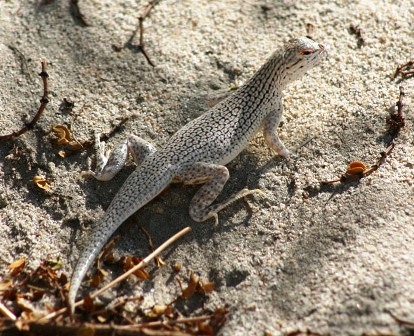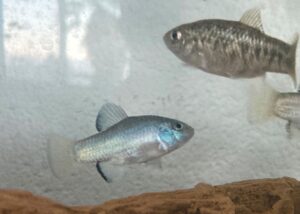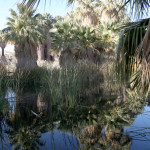




Area: The Thousand Palms Oasis Preserve has 880 acres and is contiguous with other conserved areas that are collectively known as the Coachella Valley Preserve System.
Location: Tucked into the northern edge of the Indio Hills, the Preserve offers sweeping views of the Little San Bernardino Mountains and the southern edge of Joshua Tree National Park.
Date Acquired: 2013
Acquisition Type: The Center for Natural Lands Management owns the Thousand Palms Oasis Preserve. We protect and manage species and habitats on the preserve in perpetuity.
Key Habitats: Freshwater Aquatic / Wetland, Desert Sand Dunes, Palm Woodland Oasis, Desert Wash, Desert Scrub, and Desert Riparian.
Conservation Significance

The Coachella Valley Preserve System (see “Coachella Valley Preserve System” below) was designed to protect an endemic, threatened reptile, the Coachella Valley fringe-toed lizard (Uma inornata). This lizard is found on the sand dunes that are located on the southern edge of the Coachella Valley Preserve (CV Preserve). The CNLM Preserve primarily protects the Thousand Palms Canyon, part of the alluvial system that feeds the sand dunes of the CV Preserve, but also contains a few acres of sand dune habitat. The Thousand Palms Canyon is a wide canyon that sweeps down from the little San Bernardino Mountains, through a gap in the Indio Hills, and washes onto the wide alluvial fan that borders the north edge of Palm Desert. Rainfall in the upper reaches of the hills moves rock, sand, and soil in torrential flash floods from the San Bernardino’s and the Indio Hills onto the vast floodplain at the foot of the Indio Hills. From there the fierce desert winds pick up the lightest of the soil particles, and carry them southeast along the valley floor. As wind speed slows, the particles drop onto the desert floor, creating sweeping dunes of glittering sand. Only a fragment of the once-abundant dunes remain. In addition, the canyon contains a large, rare desert wetland and two palm oases.
 Many rare and listed species use these habitats. The critically endangered desert pupfish (Cyprinodon macularius) inhabits the newly restored Simone Pond. A California species of special concern, the western yellow bat, (Lasiurus xanthinus) flits and twitters in the rare desert palm oases; an endangered species, the Swainson’s hawk (Buteo swainsonii) soars over the valley floor in migration between their breeding and wintering territories; a US Forest Service special animal, the Rosy boa (Lichanura trivirgata), slithers between the California fan palm (Washingtonia filifera) shadows, and the Federally endangered Coachella Valley milkvetch (Astragalus lentiginosus var. coachellae) can be found tucked into desert dunes in the spring providing shade and sustenance for the endangered fringe-toed lizard (Uma inornata.)
Many rare and listed species use these habitats. The critically endangered desert pupfish (Cyprinodon macularius) inhabits the newly restored Simone Pond. A California species of special concern, the western yellow bat, (Lasiurus xanthinus) flits and twitters in the rare desert palm oases; an endangered species, the Swainson’s hawk (Buteo swainsonii) soars over the valley floor in migration between their breeding and wintering territories; a US Forest Service special animal, the Rosy boa (Lichanura trivirgata), slithers between the California fan palm (Washingtonia filifera) shadows, and the Federally endangered Coachella Valley milkvetch (Astragalus lentiginosus var. coachellae) can be found tucked into desert dunes in the spring providing shade and sustenance for the endangered fringe-toed lizard (Uma inornata.)
Coachella Valley Preserve System
The Coachella Valley Preserve is actually a system of preserves. It is and has been a model of cooperation between federal, state, and private conservation efforts for managing sensitive natural areas. It is comprised of three separate Units set aside for conservation in a landmark Habitat Conservation Plan signed in 1986. These are the Whitewater Floodplain Unit, the Edom Hill/Willow Hole Unit and the Thousand Palms Unit. The Whitewater Floodplain Unit is primarily managed by the Coachella Valley Water District, and the Edom Hill Unit is managed by the BLM and Coachella Valley Association of Governments. For information on these two units, please contact those agencies.
 CNLM owns the Thousand Palms Oasis Preserve which is the heart of the Thousand Palms Preserve Unit of the Coachella Valley Preserve. This Preserve contains the Thousand Palms and McCallum Oases. The Thousand Palms Oasis Preserve is also often referred to as the Coachella Valley Preserve—which can create confusion because it is only part of the CV Preserve. The extensive trail system that goes across the entire CV Preserve System starts here in the Thousand Palms Oasis Preserve. CNLM staff coordinates the management of the trail system on the Preserve.
CNLM owns the Thousand Palms Oasis Preserve which is the heart of the Thousand Palms Preserve Unit of the Coachella Valley Preserve. This Preserve contains the Thousand Palms and McCallum Oases. The Thousand Palms Oasis Preserve is also often referred to as the Coachella Valley Preserve—which can create confusion because it is only part of the CV Preserve. The extensive trail system that goes across the entire CV Preserve System starts here in the Thousand Palms Oasis Preserve. CNLM staff coordinates the management of the trail system on the Preserve.
The other major land owners within the Thousand Palms Unit of the Coachella Valley Preserve System are the Bureau of Land Management (BLM), the U.S. Fish and Wildlife Service (USFWS), and the California Department of Fish and Wildlife (CDFW).
The BLM portion of the CV Preserve System has been designated an Area of Critical Environmental Concern (ACEC). These are areas where special management attention is needed to protect important historical, cultural, and scenic values, or fish and wildlife or other natural resources. There are no approved camping areas, nor are there any approved off-road vehicle access areas anywhere on the Preserve and we ask the public to stay on approved trails. For specific information about camping and off-road vehicle opportunities in the region, contact the local BLM office: https://www.blm.gov/office/palm-springs-south-coast-field-office.
The USFWS’s Coachella Valley National Wildlife Refuge makes up the lower third of the CV Preserve/Thousand Palms Unit. This refuge is closed to public entry to protect the federally endangered Coachella Valley fringe-toed lizard: https://www.fws.gov/saltonsea/coachella/cv_index.html.
CDFW has declared their portion of the CV Preserve/Thousand Palms Unit an Ecological Reserve. Hunting and fishing are not allowed on this land. CDFW owns land containing sand dunes and sand fields in the southern portion of the CV Preserve/Thousand Palms Unit. For information on lands open to fishing and/or hunting, contact CDFW at http://www.wildlife.ca.gov/.
The Nature Conservancy (TNC) was one of the major forces behind the formation of the Coachella Valley Preserve System. TNC transferred ownership of the Thousand Palms Oasis Preserve to the CNLM in 2013.
Public Access
Public Access (Updated 11/19/2025)
THE PRESERVE HAS THE FOLLOWING HOURS AND FACILITIES AT THIS TIME:
November 1, 2025 through April 30, 2026
• Wednesday - Sunday 7 am to 5 pm.
• Simone Pond is closed for the winter.*Due to the recent storm Thousand Palms Oasis Preserve is closed to the public Friday 11/21/2025 - Sunday 11/23/2025 for trail maintenance.
There is no public access to the Thousand Palms Oasis or its trails outside of the Preserve Hours posted above. Please be off the Preserve by closing time.
The trails at Pushawalla and Willis Palms are open every day.
We do not have different Holiday hours. The Preserve Hours are as listed above.
UNLESS OTHWISE STATED ABOVE, THE PRESERVE HAS THE FOLLOWING FACILITIES:
- There is currently no admission fee, however, we do appreciate donations. The Preserve is owned and managed by a nonprofit organization (Center for Natural Lands Management).
- The Visitors’ Center is permanently closed.
- Our bathrooms will be open during regular hours as posted above.
- PARKING:There is currently no parking available onsite for the public. Street parking is allowed by the County, but be aware of posted “No Parking” signs.
- The public can access the trails by walking through either the main gate or the two side gates south of the main gate.
- There is limited access for people with disabilities. The main oasis may be accessible, depending on mobility. The entrance gates are narrow. The trail to the oasis is not paved and the entrance is sloped. The trails are sandy and/or rocky or have steps and are not suitable for wheelchairs or other mobility equipment. Our trails are not suitable for OPDs.
THIS IS A WILDLIFE AREA AND NOT APPROPRIATE FOR DOMESTIC ANIMALS.
- DOGS AND OTHER PETS are not allowed. This includes therapy or comfort animals. Pets should not be left in vehicles because of the extreme temperatures — which can occur even in the winter.
- VALID SERVICE DOGS ARE WELCOME. Please keep your animal close to you and on a leash. Do not allow it to chase, bark, jump on other people or dig. Please bring your own clean-up bags as we do not provide them.
- Please do not remove anything (including rocks, soil, or plant material) from the Preserve.
- Use of drones is prohibited.
- Please stay on trails to protect the wildlife habitat and for your own safety.
About the Thousand Palms Oasis Preserve
For more information about the Preserve, please contact the Preserve Manager at lharalson@cnlm.org.
WHERE TO FIND US: We are located at 29200 Thousand Palms Canyon Road, Thousand Palms, CA 92276.
Our Work
CNLM’s objective is to manage and protect the desert wetlands which are the focal ecosystem of this Preserve. The hydrologic and fluvial processes that occur in the wash are crucial for the protection and creation of the sand dune habitat that occurs at the base of the Indio Hills on the south side of the Coachella Valley Preserve System. In addition, the oases serve as important migration stopovers for migrating birds, residence for bats, as well as an important resource for the desert animals in the hot, arid summers. One of the biggest threats and CNLM’s goals include control of invasive species like tamarisk species (Tamarix aphylla and Tamarix ramosissima). These plants can clog and damage fluvial systems and can spread widely and quickly.
Contact
For more information on Thousand Palms Oasis Preserve or the Center for Natural Lands Management please contact Lucas Haralson, Preserve Manager at lharalson@cnlm.org or 760.343.1234.
Mailing address for the Preserve: P.O. Box 188, Thousand Palms, CA 92276.

